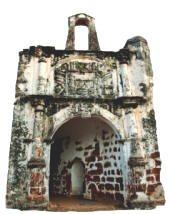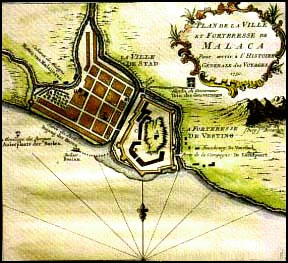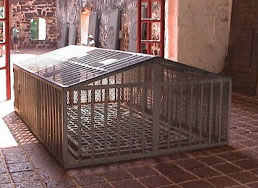Malacca ~ Porta de Santiago (A' Famosa)
& St. Paul's Church
KL Visitors Guide
HOME >
VISITORS
GUIDE >
PLACES TO
VISIT >
DAY TRIPS OUT
OF KL > MELAKA
>
PORTA DE SANTIAGO (A' FAMOSA) & ST. PAULS CHURCH
 Porta de
Santiago (A' Famosa)
Porta de
Santiago (A' Famosa)
This prominent landmark almost synonymous with Melaka is located at the foot of
St. Paul's Hill, is all that remains of a once proud Portuguese fortress
built with forced labor by the Portuguese admiral, Alfonso d’ Albuquerque in
1512.
This ‘Porta’ which means gate
in Portuguese is one of the four main gates of the larger A' Famosa" ('The
Famous' in Portuguese) fortress which expanded to include the surrounding
hills and nearby European settlements. It was a Christian fort city
that included the governor's palace, the bishop's palace, state halls, five
churches and two hospitals.

For almost 150 years, this magnificent
fort had successfully protected the Portuguese position in Melaka, until it
was overrun by the Dutch in 1641. It was damaged during the attack, but the
Dutch restored and extended the fortifications and renamed it VOC (Verenigde
Oost-Indische Compagnie - VOC) or Dutch East India Company.
After they took over in 1670,
the gate was inscribed with 'ANNO 1670' with the coat of arms of the Dutch
East India Company. The Dutch kept the fort, but moved most of the
administrative functions to the growing city outside its walls.
Its significance started to fade when the British took over and started to
settled here in the early 19th century. The British here had almost
destroyed the whole complex when Sir Stamford Raffles (founder of modern
Singapore) intervened in 1808 and was able to stop its destruction.
Unfortunately all that remains is what we see today.
 St. Paul's
Church
St. Paul's
Church
Standing at the top of St. Paul’s Hill, St Paul Church was originally known
to the early Portuguese as the Chapel of the Mother of God (Madre de Deus)
or Our Lady of the Hill (Nossa Senhora do Oiteiro).
This Catholic Chapel was built
by Duarte Coelho (the founder of Cochin China & Olinda in Brazil.), in 1521.
This was
as a result of his ship's miraculous escape from an attack in the South
China Sea, where Duarte Coelho and his crew were saved miraculously by a
sudden storm.
Successively, this chapel was
enlarged by the Portuguese, adding a second storey in 1566 and addition of a towerin
1590 to become a church.
 After
the Dutch wrestled Malacca from the Portuguese in 1641, they repaired and
reconstructed the church into a Dutch Reformed Church. It was renamed the
St. Paul's Church, a name which remains until today.
After
the Dutch wrestled Malacca from the Portuguese in 1641, they repaired and
reconstructed the church into a Dutch Reformed Church. It was renamed the
St. Paul's Church, a name which remains until today.
St. Paul’s Church was used by the Dutch for their worship for the next 112
years until they completed the construction of their own church - Christ
Church.
Due to the strategic location
of the church, the Dutch turned it into an extension of the A' Famosa Fort.
They installed gun embrasures with holes on the roof. Later, When the Christ
Church was established, the Dutch turned St. Paul’s Hill into a burial
ground for their noblemen.

Today, huge granite tombstones still stand inside the St. Paul’s Church.
Among the Dutch graves at the St. Paul’s Hill cemetery, lies the grave of
Jan Van Riebeeck. What’s so special about him? He was the founder of the
Dutch Settlement at the Cape of Good Hope in South Africa.
Jan Van Riebeeck was appointed
as Governor of Melaka after the founding of the Dutch Settlement in South
Africa. Sadly, he died in office (Stadtuys Melaka) and was buried at this
tiny cemetery.
With the beginning of the British occupation of Malacca, the church was then
used to store powder magazines, and ever since then it has stood in ruins.
St. Francis Xavier
In the year 1548, St. Francis Xavier on behalf of the Society of Jesus
received the chapel from the archbishop of Goa, Don Albuquerque. Highly
venerated by the Portuguese, it was here, that St. Francis Xavier worked
several extraordinary deeds.
 St. Francis used
to climb up this hill to pray in this church in his years of missionary and
was credited with many miracles. Following his death at San Chian in China,
the saint was brought here, and was laid to rest at an open grave (now
covered by iron grills) from the 22nd of March 1553, to the 11th of December
of the same year, before being delivered to
Goa, India.
St. Francis used
to climb up this hill to pray in this church in his years of missionary and
was credited with many miracles. Following his death at San Chian in China,
the saint was brought here, and was laid to rest at an open grave (now
covered by iron grills) from the 22nd of March 1553, to the 11th of December
of the same year, before being delivered to
Goa, India.
Canonization of St. Francis
Xavier was done in 1614. The Pope requested St. Francis’ right forearm, which
he used to bless and baptize his converts be brought to Rome, in order to be
canonized. As, legends have it, when the arm was detached by Priest Gen. Claudio Acquaviva - the wound was said to have dripped blood!
Anyway in 1952, a statue of
St. Francis Xavier was built to commemorate the passing of the saint in
Melaka from 1545 to 1552 while spreading Catholicism in this region.
Originally, the statue was completely constructed with the right arm in
place. However, on the morning after the consecration ceremony, a large
casuarinas tree fell on it and broke off the right arm, resulted in a statue
with missing arm that you see today.
 St. Francis Xavier is still on display at the Basilica of
Bom Jesus in Goa, India, that is open to the public once every 10 years. The
body is said to be preserved in fairly good condition, even though it has
been rested for nearly 500 years. Today, the bare tomb in this roofless
church of St. Paul’s Church, is a silent reminder of a great saint. Each
year, on the Sunday nearest to 3rd December, thousands of pilgrims and
devotees From all over the region throng the ruins of St. Paul’s Church in
Melaka to celebrate the Feast of St. Francis Xavier.
St. Francis Xavier is still on display at the Basilica of
Bom Jesus in Goa, India, that is open to the public once every 10 years. The
body is said to be preserved in fairly good condition, even though it has
been rested for nearly 500 years. Today, the bare tomb in this roofless
church of St. Paul’s Church, is a silent reminder of a great saint. Each
year, on the Sunday nearest to 3rd December, thousands of pilgrims and
devotees From all over the region throng the ruins of St. Paul’s Church in
Melaka to celebrate the Feast of St. Francis Xavier.
Melaka ~ Places to Visit
 Melaka ~ The Porta de
Santiago & St. Pauls Church
Melaka ~ The Porta de
Santiago & St. Pauls Church
 Melaka ~
Stadhuys & Christ Church
Melaka ~
Stadhuys & Christ Church
 Melaka ~
Portuguese Settlement & St. Peter's Church
Melaka ~
Portuguese Settlement & St. Peter's Church
 Melaka ~
Harmony & Jonker Street
Melaka ~
Harmony & Jonker Street
 Melaka ~
Melaka
River Cruise & Observation Tower
Melaka ~
Melaka
River Cruise & Observation Tower
Best Way to Visit - Historical
Melaka Tour
A Full day tour to take you back into the past 600 years as you visit
Malacca city's historical landmarks and its legacy.
 PLACES & SIGHTSEEING ~ DAY TRIPS OUT OF KL
PLACES & SIGHTSEEING ~ DAY TRIPS OUT OF KL
• GENTING HIGHLANDS • FRASER HILL •
MALACCA
• K. SELANGOR &
FIREFLIES
•
ELEPHANT SANCTUARY
• CAMERON HIGHLANDS •
PUTRAJAYA


 Porta de
Santiago (A' Famosa)
Porta de
Santiago (A' Famosa)
 St. Paul's
Church
St. Paul's
Church
 St. Francis used
to climb up this hill to pray in this church in his years of missionary and
was credited with many miracles. Following his death at San Chian in China,
the saint was brought here, and was laid to rest at an open grave (now
covered by iron grills) from the 22nd of March 1553, to the 11th of December
of the same year, before being delivered to
Goa, India.
St. Francis used
to climb up this hill to pray in this church in his years of missionary and
was credited with many miracles. Following his death at San Chian in China,
the saint was brought here, and was laid to rest at an open grave (now
covered by iron grills) from the 22nd of March 1553, to the 11th of December
of the same year, before being delivered to
Goa, India.
 St. Francis Xavier is still on display at the Basilica of
Bom Jesus in Goa, India, that is open to the public once every 10 years. The
body is said to be preserved in fairly good condition, even though it has
been rested for nearly 500 years. Today, the bare tomb in this roofless
church of St. Paul’s Church, is a silent reminder of a great saint. Each
year, on the Sunday nearest to 3rd December, thousands of pilgrims and
devotees From all over the region throng the ruins of St. Paul’s Church in
Melaka to celebrate the Feast of St. Francis Xavier.
St. Francis Xavier is still on display at the Basilica of
Bom Jesus in Goa, India, that is open to the public once every 10 years. The
body is said to be preserved in fairly good condition, even though it has
been rested for nearly 500 years. Today, the bare tomb in this roofless
church of St. Paul’s Church, is a silent reminder of a great saint. Each
year, on the Sunday nearest to 3rd December, thousands of pilgrims and
devotees From all over the region throng the ruins of St. Paul’s Church in
Melaka to celebrate the Feast of St. Francis Xavier.